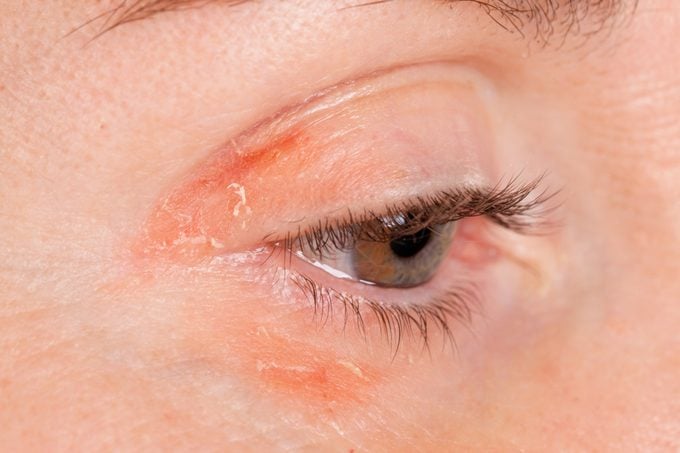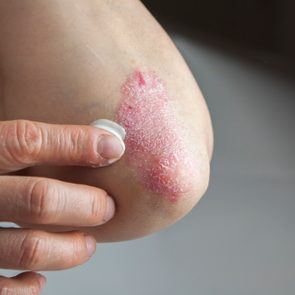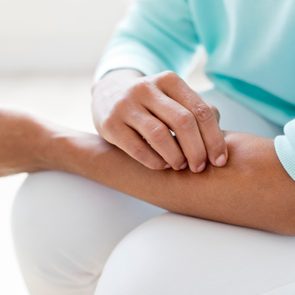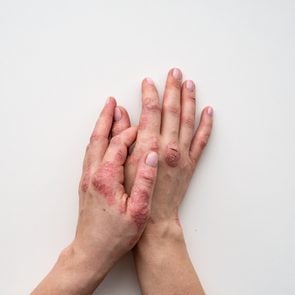8 Tips for Dealing With Psoriasis on Your Eyelids
Updated: Jul. 06, 2021
Treating psoriasis on your eyelids can be tricky. Find relief with these treatment options and lifestyle tips.
Dealing with psoriasis
It may not be the first place you think about when you hear the word “psoriasis,” but you can certainly find signs of the skin condition on your eyelid.
Affecting more than eight million people in the United States, psoriasis is an inflammatory skin disorder that occurs when your immune system kicks into overdrive and ramps up the production of skin cells.
Instead of shedding as they would from psoriasis-free skin, these cells build up, forming raised, reddened plaques that may itch and/or burn. These plaques may also be covered with a silvery scales.
Psoriasis can affect any area of your body, but the knees, elbows, and scalp are the most commonly affected spots.
Psoriasis runs more than skin deep. The underlying inflammation associated with psoriasis may increase risk for heart disease, diabetes, and depression.
The plaques can also damage your self-esteem and self-confidence—especially when they occur in highly visible areas like your face. (Or even less visible areas, like the genitals.)

What is eyelid psoriasis?
An estimated 50 percent of people with psoriasis may develop symptoms on their faces, most commonly on or near the eyebrows, between the nose and upper lip, or across the upper forehead and hairline, according to the National Psoriasis Foundation.
Eyelid psoriasis isn’t all that common, says Jerry Bagel, MD, a dermatologist at East Windsor Dermatology in East Windsor, New Jersey, and a member of the National Psoriasis Foundation’s board of directors.
Eyelid psoriasis could be spillover psoriasis from your scalp, eyebrows, or ears.
Symptoms of eyelid psoriasis include:
- Redness or discoloration
- Dryness
- Scaling
- Crusting around the eyelids
These symptoms may lead to irritation, pain, and itching.
When this occurs, you can develop blepharitis, an inflammation of the eyelids, Dr. Bagel says.
“It’s not just the eyelid skin either. The hair follicles, where the eyelashes come from, can get involved and become clogged,” he adds. This sets the stage for bacterial infections and painful eye styes.
The good news? Unlike palmoplantar psoriasis and other notoriously vexing types of psoriasis, eyelid psoriasis does not necessarily travel with psoriatic arthritis.
Diagnosing eyelid psoriasis
Eyelid psoriasis may look like other skin conditions, says Gary Goldenberg, MD, an assistant clinical professor of dermatology at Icahn School of Medicine at Mount Sinai in New York City.
This list of imitators includes eczema, contact or allergic dermatitis, seborrheic dermatitis (dandruff), or even the skin infection impetigo.
“Any type of eyelid dermatitis or superficial skin infection on your eyelids could be confused for psoriasis,” he says.
Often diagnosis is a game of ruling out other, similar skin conditions.
“Eyelid psoriasis is not common, so we rule out more common causes, especially when there are no other skin rashes or plaques on the body,” Dr. Goldenberg says.
Treating eyelid psoriasis
There are many different treatments that can help alleviate eyelid psoriasis symptoms. These range from steroids to biologic drugs.
If you develop some irritation and/or dry skin on your eyelids and you don’t have a history of psoriasis, you can treat it at home initially, says Dr. Goldenberg.
“You can even try a low-dose, over-the-counter steroid cream,” he says. “But if it doesn’t get better in a few days or gets worse, see your dermatologist to get a proper diagnosis.”
You’ll likely see a dermatologist for psoriasis treatment. That said, if eyelid psoriasis affects your vision, you will also need to see an ophthalmologist, Dr. Bagel says.
Steroids
When psoriasis occurs on your body, your dermatologist can prescribe a powerful steroid, delivered topically, and within a week, it will get much better, Dr. Bagel says.
This is not always the case if psoriasis is on your eyelids, however.
“Steroids will thin skin and can be absorbed into your eyeball and cause cataracts and glaucoma, both of which may result in vision loss,” he says.
Instead of heavy-duty steroids, your dermatologist may suggest mild ones for your eyelid psoriasis, according to Dr. Bagel.
Topical options
Other topical options for psoriasis on your eyelid include calcineurin inhibitors such as Protopic (tacrolimus ointment) and Elidel (1 percent pimecrolimus cream).
These steroid-free creams are used off-label for psoriasis to reduce inflammation and itch.
“You can use them for prolonged periods without worry about thinning skin, glaucoma, or cataracts,” says Dr. Bagel.
The downside? They can be irritating—at least initially.
Biologics and disease-modifying agents
If psoriasis also affects other parts of your body or is taking its toll on your quality of life, your dermatologist may suggest systemic treatments like biologics or other disease-modifying agents.
Biologic drugs target specific proteins in the immune system that kick-start the inflammation cascade. The severity of your psoriasis will determine whether you’ll need a biologic drug.
Usually, a biologic drug is prescribed when psoriasis symptoms range from moderate to severe, according to the Journal of the American Academy of Dermatology.
Use a cold compress
If you’re following a steroid treatment, get the most out of it by placing a cold compress on your eyelids for 10 minutes twice a day.
“This gets rid of crusting and scale, so you get more steroid to penetrate and it works better,” says Dr. Bagel.
Lifestyle tips for eyelid psoriasis
Living with eyelid psoriasis becomes more manageable when you’re mindful of your lifestyle habits. So practice good skin care, follow a healthful diet, and do whatever you can to reduce stress, a trigger for flares.
Practice good skin care
A good skin care routine for psoriasis can go a long way toward preventing flares and making sure your eyelid psoriasis doesn’t become infected or inflamed, Dr. Goldenberg says.
Moisturizing this area is important.
“Choose a hypoallergenic product,” he says, noting it’ll be less likely to cause any irritation. “I recommend a gentle skin care regimen too.”
Avoid touching and picking
Don’t rub your eyes or pick at the scales, Dr. Goldenberg says. As tempting as this may be, the instant gratification will only make things worse in the long run.
“For every one flake you pick, 100 will come back,” he says.
Skip eye makeup
Skip the makeup when your eyelids are red and flaky, he says. Eye makeup can make matters worse, not better.
Follow an anti-inflammatory diet
Eating a healthy anti-inflammatory diet can help keep psoriasis flares at bay, Dr. Goldenberg says.
“Cut out white flour, white sugar, and dairy, as these foods tend to be pro-inflammatory,” he says. “Instead, eat lots of fruits and vegetables and more seeds than grains.”
Psoriasis on your eyelids is relatively rare, but seeking care with a dermatologist and an eye specialist can help get the symptoms under control and protect your vision.
Next, learn the best skin care routine for psoriasis, according to dermatologists.






















